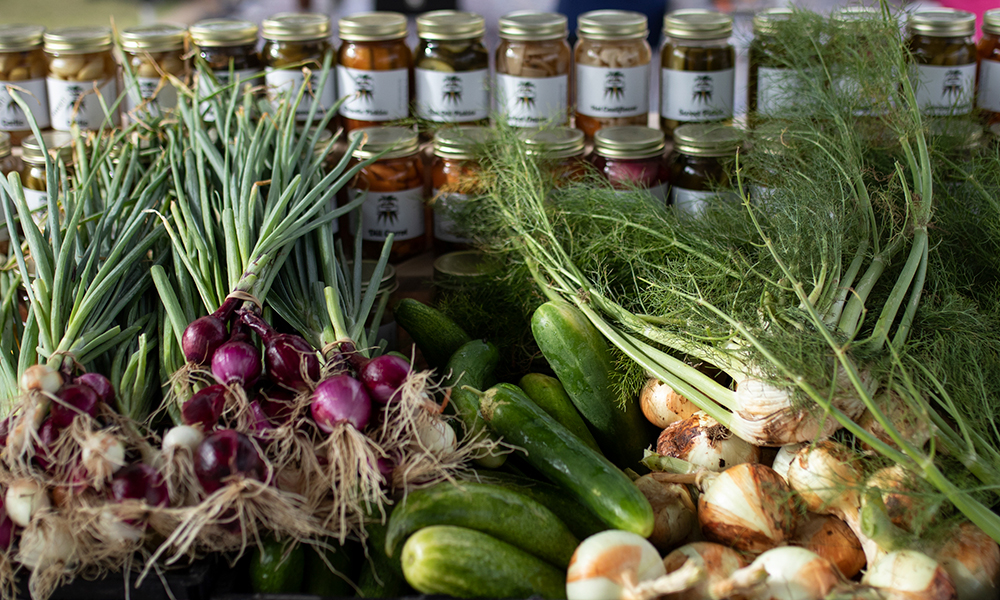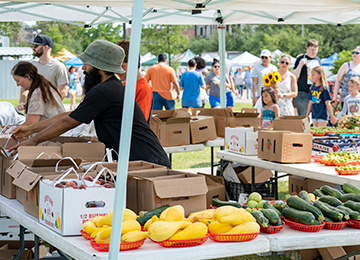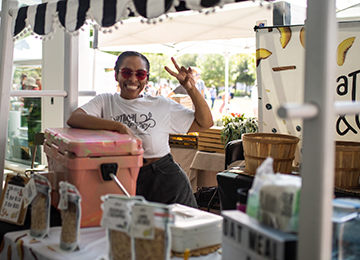Farmers Markets Help Grow Local Economies
Farmers markets do more than sell vegetables, eggs and grass-fed meat. They provide a central shopping and gathering place for communities and bring shoppers to nearby businesses, but most importantly, they support local and small farms.
Photos courtesy of Texas Farmers Market and Urban Harvest

Bernhardts Farm, Texas Farmers Market
A 2017 survey (PDF) published by the National Young Farmers Coalition (NYFC) found that farmers over the age of 65 outnumbered farmers under the age of 35 by six to one. The survey noted that farmers markets provide an important outlet for supporting farming occupations, especially for younger farmers who already may face obstacles related to land accessibility, student-loan debt, health insurance and finding skilled labor.
Survey respondents, composed of NYFC members under age 40, said farmers markets accounted for the second-highest proportion of their farm sales (18 percent), with the highest proportion (19 percent) resulting from direct sales to customers who pay upfront for produce.
Laura McDonald, executive director of Texas Farmers Market, with locations in Cedar Park and Austin, says it’s important for farmers markets to provide ongoing support for farmers and ranchers so that Central Texans can continue to have access to fresh produce and meats.
“There are very real concerns about maintaining access to these products,” she says, “as the cost of farmland in Central Texas rises rapidly … and farmland is disappearing at a rapid rate as [older] farmers retire with no one to take over their businesses.”
The good news is that since the U.S. Department of Agriculture (USDA) began recording the number of farmers markets, their prevalence has increased 364 percent (PDF) — from 1,755 in 1994 to 8,140 in 2019.
The report also revealed that on an average day, 916 households shopped at each U.S. farmers market and spent $14,547. Furthermore, businesses near or around farmers markets benefitted from proximity. On the vendor side, smaller farm operations tended to purchase their supplies locally, thus benefitting local economies and keeping their dollars spent within communities.
“Other local businesses definitely benefit,” confirms Tyler Horne, director of farmers markets for the market operated in Houston by Urban Harvest, which also has an educational arm. “On a typical Saturday, we have 3,000+ shoppers. When the weather is perfect, it can double that. We are open 8 a.m. to noon, and in the 14 years I’ve been involved, we’ve been closed less than half a dozen times.”
McDonald says Texas Farmers Market averages about 3,000 shoppers in Cedar Park and 4,000 in Austin per market day. “Our markets drive huge amounts of foot traffic to neighboring businesses, and our location partners see us as an integral part of their success.”

Produce at Urban Harvest’s market
Both Urban Harvest and Texas Farmers Market are independent nonprofits, which is not the case for all farmers markets, according to a 2021 article that focuses on their economic and social impact. Business structures for farmers markets range from private for-profits and private social enterprises to markets run by city or county governments.
Regardless of organizational structure, the roughly 150 farmers markets across Texas and the numbers of shoppers they attract start to add up for local communities. Based on the results of their most recent annual survey, Horne says Urban Harvest estimated a $4.32 million economic impact on the local community.
The figure may seem especially surprising because of COVID, but it turns out the pandemic did not hurt business at Urban Harvest’s market or Texas Farmers Market.
“During the pandemic, we did well overall,” says Horne. “We had to begin offering drive-thru service but figured it out. Year-over-year, we had one of our better years because people didn’t want to go inside grocery stores.”
Restaurants near the Houston-based farmers market benefitted as well. “We worked with some restaurants to help them sell at the market, which was different,” Horne says, “but it felt great to create opportunities for people and restaurants going through a tough time.”
Urban Harvest’s market retained many of the new shoppers it gained during the pandemic. McDonald says the pandemic boosted sales at both locations of Texas Farmers Market as well.
“Since people felt more comfortable being able to shop outdoors,” she says, “many people started shopping at the markets weekly during the pandemic and continued to do so as things opened back up. Our weekly attendance continues to grow.”
McDonald adds that one of the advantages of farmers markets is the ability to be nimble in times of crisis. “Because our vendors do a lot of sourcing locally,” she says, “they are less impacted by supply chain issues, which is another important reason to support our local producers.”
In addition to being nimble, vendors at farmers markets may have another advantage. According to the Farmers Market Coalition, a national advocacy group, more than 85 percent of market vendors travel fewer than 50 miles to reach their farmers market, and more than half travel fewer than 10 miles. By comparison, fruit and vegetables sold in grocery stores may take seven to 10 days to reach their destinations and travel up to 1,200 miles.

Oatmeal & Company, Texas Farmers Market
As for the future of farmers markets, McDonald believes demand for fresh produce will continue to grow and that supporting that growth means supporting Texas farmers and ranchers.
Tyler Horne agrees. When he started his job in 2008, Urban Harvest’s market had 25 vendors. It now has more than 100. Likewise, Texas Farmers Market has grown from around 20 vendors to about 130 across both locations.
“More people want to be a part of this,” Horne says, “and I see the future — I hope — with younger and more diversified farmer operations. One advantage for our vendors is that year after year, we’re consistently here for them. If vendors aren’t doing well, we aren’t doing well, so we’re very loyal to them.” FN
Interested in other topics related to agriculture in Texas? Read about the state’s dairy industry and how it’s thrived in recent years.

